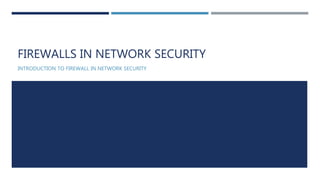Firewalls in network security
- 1. FIREWALLS IN NETWORK SECURITY INTRODUCTION TO FIREWALL IN NETWORK SECURITY
- 2. WHAT IS NETWORK SECURITY? Network security is any activity designed to protect the usability and integrity of your network and data. It includes both hardware and software technologies. Effective network security manages access to the network. It targets a variety of threats and stops them from entering or spreading on your network.
- 3. UNDERSTANDING FIREWALL Firewalls come in many different shapes and size and sometime the firewall is a collection of several different computer. All communication must pass through the firewall. The effectiveness of the firewall is greatly reduced if an alternative network routing path The firewall permits only traffic that is authorized. The firewall cannot be relied upon to differentiate between authorized and unauthorized traffic
- 4. TYPES OF FIREWALL Proxy Firewall Stateful Inspection 3.Unified Threat Management (UTM) Firewall 4.Next-Generation Firewall (NGFW) 5.Threat-Focused NGFW
- 6. INSIGHT INTO FIREWALL PACKET FILTER Simplest of components Uses transport-layer information only IP Source Address, Destination Address Protocol/Next Header (TCP, UDP, ICMP, etc) TCP or UDP source & destination ports TCP Flags (SYN, ACK, FIN, RST, PSH, etc) ICMP message type
- 7. FIREWALL OUTLINES Packet filtering Application gateways Circuit gateways Combination of above is dynamic packet filter
- 8. FIREWALL GATEWAY Firewall runs set of proxy programs Proxies filter incoming, outgoing packets All incoming traffic directed to firewall Policy embedded in proxy programs Two kinds of proxies Application-level gateways/proxies Circuit-level gateways/proxies
- 9. Thank you for watching the presentation! Get you career in network defense accelerated now with network security certification
